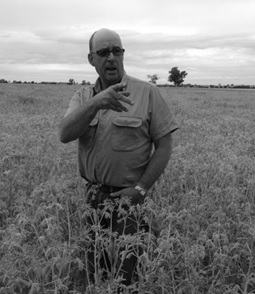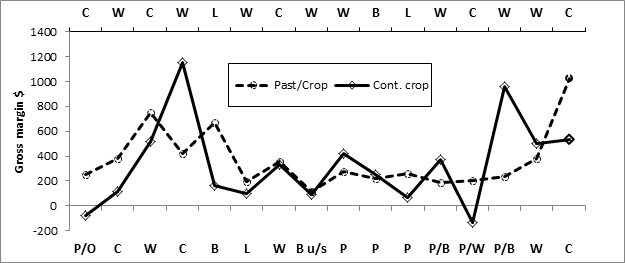Pulses pay their way - A grower case study
Author: Neil and Margaret Schirmer | Date: 26 Feb 2013
Neil and Margaret Schirmer
Hopefield, Lockhart, NSW
Keywords: rotation, pulse, pulse manure,
Take home messages:
- Including a legume pulse manure phase as well as a pulse in my continuous crop system is the plan for the future to provide ‘home grown’ organic nitrogen.
- In addition, the legume manure will also provide opportunities for integrated weed management, conservation of moisture and soil revitalisation.
- The right pulse selection will provide a cash return as well as benefiting future crops.
- Plan your crop rotation at least a couple of years ahead – crop and chemical choices.
- Commitment and attention to detail are needed to keep rotations on track.
- Invest some time into developing pulse marketing contacts.
Background
History
Neil is a third generation farmer with his Grandfather taking up the farm in 1910. The farm is now run as a partnership with wife, Margaret.
Farm location
8 km NE Lockhart in southern NSW
Property size
700 ha
Soils
Mostly well drained red loam, with approximately 100 ha of heavier grey clay.
All soils were acid with pHCa as low as 4.3 and exchangeable Aluminium of up to 10%. Liming started in 1993 and now the whole farm has been limed to a pHCa target of 5.0 – 5.2 and no exchangeable Aluminium. This has taken 2 – 3 applications over a 19 year period, with some paddocks now having received a total of 4.0 – 5.0 t/ha.
Rainfall
Annual average is 450 mm; growing season rainfall is 280 mm
Enterprises
After a long tradition of mixed farming we have gradually increased the cropping area from 50:50, phasing out pastures all together in 2010. This was done to make labour easier and optimise the return on investment in up-to-date equipment.
Equipment
Gason 4100 Cultimaster on 10″ spacing with knife points, Manutec press wheels and Manutec coulters. A no till system is employed, with stubble burning avoided where possible, other than for strategic purposes, such as weed seed reduction.
The system
The farm system uses a rotation of crops based on proven agronomic and economic principles, Crops are divided into:
a) Broad leaf – canola, lupins, faba beans and manure pulse - all fitting different roles.
b) Cereals – principally wheat, although barley is grown, if there is an agronomic or marketing advantage.
Crop nutrition is on a soil balance basis with nitrogen, phosphorus and sulphur added as required to replace that taken out in grain.
On the long term cropped area the usual rotation has been…
Pulse – Wheat – Wheat – TT Canola – Wheat – Wheat

Figure 1. Current rotation on cropped area.
As the diagram shows the current rotation is heavily biased to nitrogen exploiting crops, and as a result of a series of factors we are now looking to include a pulse manure crop in future to provide better balance.
The current sequence begins with a legume...
Pulse choice
Choice: Albus lupins and Faba beans
Historically, the farm produced Angustifolius (narrow leaf) lupins. In 1997 we switched to Albus Lupins for both yield and marketing qualities. On our soils, Kiev Mutant out-yielded the Angustifolius type and we were also able to get a better price in most seasons. Our current variety is Luxor.

Figure 2. A 2.5 t/ha Lupin crop 2012.
We first grew Faba beans in 1997 and 1998. After success in 1997 we watched in frustration as disease ‘ate’ the 1998 crop, despite several applications of fungicide. After 1998 it was decided that disease management in Faba beans was too hard and 2012 was the first time we had grown them since. The current varieties have a more open canopy and good disease resistance. These varietal improvements combined with better boom-spray technology means Faba beans are now a viable choice, especially on the heavier soils. Our current variety is Farah and next year we are growing Rana for seed build up.
In the rotation:
Pulse follows wheat, providing an opportunity for lower input costs because of a lower Nitrogen fertiliser requirement. There are also excellent opportunities for grass weed control, including crop-topping.
Wheat following a pulse allows for a more fertile paddock than after either canola or wheat.
According to Neil, this saving is usually equivalent to around 100 kg/ha of urea. Cheap and effective broadleaf weed control is possible.
Wheat following wheat – can be quite profitable provided fungicides are used to suppress cereal disease.
Canola provides a robust weed control opportunity with triazine tolerant varieties coupled with clethodim allowing excellent weed control for problem weeds such as wild radish, annual ryegrass and wild oats. Windrowing also ‘picks up’ surviving weeds and when harvested with the straw spinners off, allows for chaff trails to be burnt as a further opportunity for seed bank reduction.
Wheat following canola has a relatively low trash level and with Neil’s seeder system allows for higher label rates of Trifluralin to be used very effectively. Another opportunity for cheap, effective broadleaf weed control is afforded.
Wheat following wheat – as above, ensure appropriate cereal disease suppression strategies are in place.
As the whole farm has only been in continuous crop for two seasons his system is still evolving. Neil knows he is 'living' on soil nitrogen built up by pasture and pulses and accepts that in future his rotation will need to adapt. In 2013 Neil plans to introduce a pulse manure to help with integrated weed management (IWM), fallow moisture conservation as well as the associated soil benefits including nitrogen build up.
A pulse manure has many benefits and will add robustness and more balance to Neil’s system as a manure phase mimics a pasture in that it can produce up to 200 kg/N/ha, providing background nitrogen for about 2 ½ cereal crops as well as opportunities for IWM and a moisture conserving fallow.
Keys to success
- Commitment and attention to detail are needed to grow a good crop or pasture.
- Start with a sound rotation. Plan at least a couple of years ahead in terms of weeds – control broadleaf weeds in cereals and grass weeds in canola and lupins. Plan the use of chemicals with long residual effects so that there is no adverse affect on any crop.
- Marketing, like paddock preparation, marketing pulses requires time and effort. If you do not want to end up 'skinned' you need to develop your contacts and stay in touch all year round.
Following is an actual representation of an 80 hectare paddock that was split in two 16 years ago. One side continued a mixed farming rotation (dashed line) and the other introduced a continuous cropping system (solid line). The graphs records the gross margins* derived on each half of the paddock. *Note: Gross margins are calculated based on fuel, fertiliser, chemical and farm operating costs and excludes interest, drawings and principal repayments.

Figure 3. Gross margin representation comparing continuous cropping (solid line) and mixed farming (dashed line).
Key:
|
B |
Barley |
P |
Pasture |
|
B u/s |
Barley undersown |
P/B |
Pasture with Barley drilled in |
|
C |
Canola |
P/O |
Pasture with Oats drilled in |
|
L |
Lupins |
P/W |
Pasture with Wheat drilled in |
|
W |
Wheat |
|
|
Key points
The cumulative average of these gross margins are: $336.80/ha/yr for the continuous crop portion and $371.70/ha/yr for the mixed cropped section.
While the continuous crop has shown the potential in a good year to provide the best return, it also demonstrates the capacity to deliver the lowest return.
The mixed farming result shows less volatility overall and on average over the 16 years produces a higher return by almost 10%.
Of particular interest however, are the last data points, both of which represent a Canola crop in 2012 following a wheat crop in 2011 – why the disparity in the result? Both had the same inputs yet the canola on the portion of the original paddock that has been running the mixed farming rotation yielded almost a tonne per hectare more than its continuous crop counterpart.
I and many other growers who are starting to observe such trends will be looking for answers – is this just a soil nitrogen effect or are there wider soil health implications of a continuous crop sequence that relies largely on canola and wheat?
Contact details
Neil and Margaret Schirmer
Hopefield, Lockhart NSW
0427 365 001
Was this page helpful?
YOUR FEEDBACK
